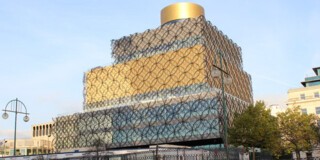At the Library of Birmingham
Gillian Darley
Perhaps the best thing about Birmingham’s newest civic building on Centenary Square is what they’ve called it. No beating about the bush, no equivocation: it’s a library. After all the weasel words – ‘idea stores’, ‘learning centres’, ‘discovery centres’ – it’s cheering to see the book is back. Though the loudly trumpeted opening, set against what the Library Campaign reckons is a 25 per cent loss of public libraries since 2009, just the beginning of a terrible cull, bears out the questionable orthodoxy that, as with hospitals, bigger is better.
The enormous, complex building has been designed by the Dutch firm Mecanoo (headed by Francine Houben). It replaces a well-liked 1970s Brutalist library, with a hospitable stepped amphitheatre in front where, weather allowing, Birmingham students (and others) have been gathering like starlings for thirty years. Now apparently unfit for purpose, the old library is destined for demolition and redevelopment, presumably to pay for the new library and rehabbed (1970s) Rep Theatre next door.
Externally, the seven-storey Mecanoo building is eye-catching and uncompromising, a huge pile of geometric forms surmounted by a drum. Most of the structure is wrapped in a kind of farthingale, a huge netted carapace: the interlocking metal circles, the designers say, refer to the city’s manufacturing and artisanal past and present. The walls of the upper areas – which contain the archives and Shakespeare material – are opaque and golden. Gold means old here.
Inside, there’s a mundane glazed lobby which leads either down to an appealing, warren-like Children’s Library and an outside arena (a nod to the old amphitheatre?), or up, via a ziggurat of escalators, to the huge and handsome Book Rotunda, which houses about 40 per cent of the library’s current holdings on open shelves. There are planted outdoor spaces on the third and seventh floors. Also on the seventh floor is the Shakespeare Memorial Room, a barrel-vaulted, panelled interior from the 1880s library, which fits awkwardly in the gilded drum.
The new building offers a bewildering array of functions; what’s less clear is how easy it will be to find somewhere to sit down quietly and comfortably to read. Ken Worpole says in Contemporary Library Architecture that a modern library is ‘an abiding symbol of civility and democratic intellect’; in Birmingham, this idea seems blurred within a flurry of distractions. But I hope that the public to whom it is dedicated will prove me wrong.
